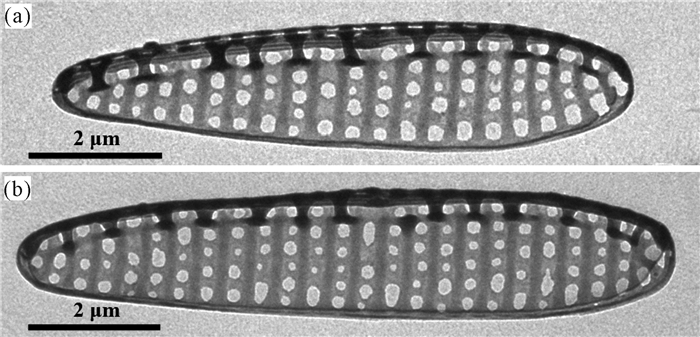2. 厦门大学生命科学学院, 福建厦门 361102;
3. 近海海洋环境科学国家重点实验室(厦门大学), 福建厦门 361102;
4. 滨海湿地生态系统教育部重点实验室(厦门大学), 福建厦门 361102
2. School of Life Sciences, Xiamen University, Xiamen, Fujian, 361102, China;
3. State Key Laboratory of Marine Environmental Science(Xiamen University), Xiamen, Fujian, 361102, China;
4. Key Laboratory of the Coastal and Wetland Ecosystems(Xiamen University), Ministry of Education, Xiamen, Fujian, 361102, China
近年来,“动表生硅藻(Epizoic Diatom)”一词经常出现在海洋硅藻分类学的相关文献中,国外已有不少学者针对这一特殊硅藻类群进行研究报道[1-3],这些研究大多关注的是海洋桡足类和海龟上的动表生硅藻[4-6],许多新的硅藻属种已从这些海洋动物宿主体表被发现并描述,如太平洋假带状藻Pseudohimantidium pacificum (Hustedt & Krasske)、胡氏原缝藻Protoraphis hustedtiana (Simonsen)、着鲸藻属Epiphalaina Holmes (Nagasawa & Takano)、海豚藻属Tursiocola Holmes (Nagasawa & Takano)、短杵藻属Tripterion Holmes (Nagasawa & Takano),等等[7-14]。在中国海区,目前已报道的动表生硅藻仅有3种:太平洋假带状藻、透明伪镰刀藻Pseudofalcula hyalina (Takano)Gómez,Wang & Lin、胡氏原缝藻[7, 15, 16]。因此,对我国动表生硅藻分类学和生态学的进一步研究将丰富我国的硅藻多样性和区系分布信息。
楔菱藻属Gomphonitzschia Grunow隶属于硅藻门Bacillariophyta、羽纹纲Pennatae、双菱藻目Surirellales、菱形藻科Nitzschiaceae,该属的主要特征为细胞壳面观和环面观均呈楔形,在壳面的一侧和另一壳面的对角一侧各有1条管壳缝,营附着生活,有或无胶质柄[17]。根据AlgaeBase网站的统计结果[18]以及Witkowski等[19]的研究报道,目前楔菱藻属共有8个种类,主要分布在海洋中,个别种类可生活在淡水中。我国硅藻分类学家金德祥先生曾在《中国海洋底栖硅藻类:上卷》[17]中记录1种,即中国楔菱藻G.chinensis Skvortzow,此后国内再无本属其他种类的报道。
笔者在对中国黄海水域中的动表生硅藻进行调查和种类鉴定时,发现中国硅藻的1个新记录种——弱小楔菱藻G.exigua Sovereign。本研究以金德祥分类系统[20]为基础,结合透射电子显微镜(TEM)的观察结果,对该种的形态特征进行详细描述,并讨论该种的生态分布特点,以丰富我国海洋硅藻学研究的基础资料。
1 材料与方法本研究团队于2017年12月至2018年1月搭载“东方红2”综合调查船在黄海水域采集动表生硅藻样品,并于2017年12月22日在H26站点(33°58.652′N,124°02.573′E)采得1只隆背体壮蟹Romaleon gibbosulum De Haan。为了分离其体表的动表生硅藻,首先将蟹置于过滤(滤膜孔径0.45 μm)后的海水中清洗,以去除污泥和杂质;然后使用新牙刷将蟹体表的附着藻类刷下,现场用含5%(V∶V)福尔马林的海水溶液固定;最后将样品带回实验室做进一步处理。
实验室内,首先在试管中将固定后的藻类样品与浓盐酸(36%-38%)等体积混合;然后将试管转移至沸水浴中加热20 min,以去除样品中的有机杂质;试管冷却至室温后,加入蒸馏水,自然沉降24 h,吸去上清液,再次添加蒸馏水,反复清洗7-8次,直至样品呈中性;最后吸取20 μL浓缩后的硅藻样品,滴加至100目的碳膜铜网上,自然风干后,将附有硅质壳的铜网置于JEOL JSM-2100HC型透射电子显微镜(TEM)下观察并拍照。
2 结果与分析弱小楔菱藻Gomphonitzschia exigua Sovereign
Sovereign 1958, p.131, Ⅳ/41, 42.
形态特征:壳面楔形,长8.4-10.0 μm,宽1.8-2.1 μm,从基部到顶部宽度逐渐增加(图 1)。管壳缝偏心,船骨突10 μm内14-15个。点条纹由大小不一的近圆形点纹组成,平行排列,10 μm内24-26条。

|
| 图 1 弱小楔菱藻(透射电子显微镜照片) Fig. 1 Gomphonitzschia exigua Sovereign (Transmission electron microphotographs) |
生态习性:淡水或海水中生活,可在动物体表生活,也可在淡水水体中发现。
地理分布:本种首次记录于美国俄勒冈州的火山湖(Crater Lake)。本研究中的样品采自中国黄海,为中国首次记录。
3 讨论弱小楔菱藻最初由Sovereign[21]在1958年发表,发现地为美国俄勒冈州的火山湖。该种与阿格玛楔菱藻G.agma (Hohn & Hellerman)、昂氏楔菱藻G.ungeri (Grunow)较为相似,但仍存在一些形态上的差异,主要差异点:(1)在细胞大小方面,弱小楔菱藻的细胞较小(长8.4-10.0 μm,宽1.8-2.1 μm),而阿格玛楔菱藻和昂氏楔菱藻的细胞较大(前者长24.8 μm,宽3.1 μm;后者长28.0-35.0 μm,宽4.0-5.0 μm);(2)在船骨突密度方面,弱小楔菱藻的船骨突密度较高(10 μm内14-15个),而阿格玛楔菱藻和昂氏楔菱藻的船骨突密度较低(前者10 μm内8-9个;后者10 μm内10个);(3)在点条纹密度方面,弱小楔菱藻的点条纹密度较高(10 μm内24-26条),而昂氏楔菱藻的点条纹密度较低(10 μm内20条)[22, 23]。
本研究中采自中国黄海的弱小楔菱藻种群与其美国火山湖模式种群在细胞大小、点条纹密度和船骨突密度等方面相符(Sovereign[21]记载为长11-13 μm,宽2.7-3.2 μm,船骨突10 μm内10-13个,点条纹10 μm内26-30条),因此可以确定本研究中的标本就是弱小楔菱藻。但两个种群之间仍存在细微差异,根据Sovereign[21]的手绘图,美国种群的硅质壳基部有延伸特征,而中国种群的硅质壳基部没有延伸。
动表生硅藻即生活在动物体表的硅藻。根据已有的研究结果,生活在脊椎动物上的动表生硅藻种类和数量一般要比无脊椎动物上的多,且两类宿主上的动表生硅藻形态有着明显的差异,如在脊椎动物上发现的动表生硅藻新属种主要是双壳缝的海洋异极硅藻,而在无脊椎动物上发现的动表生硅藻新属种都是无壳缝类硅藻[8, 11-14, 24, 25]。这一现象是偶然的还是必然的,需要进一步深入研究和比较分析。在本研究中,弱小楔菱藻为生活在隆背体壮蟹上的动表生硅藻。但是根据Sovereign[21]的描述,作者无法确定该种的模式标本是否营附着生活。此外,弱小楔菱藻的模式标本发现于淡水中,但是本研究的标本采自海洋,因此可初步确定该种存在淡水种群和海水种群。本研究扩大了弱小楔菱藻的记录分布范围,并且丰富了该种的生态习性类型。
| [1] |
SAR E A, SUNESEN I. The epizoic marine diatom Sceptronema orientale (Licmophoraceae, Licmophorales): Epitypification and emendation of specific and generic descriptions[J]. Phytotaxa, 2014, 177(5): 269-279. DOI:10.11646/phytotaxa.177.5.3 |
| [2] |
MAJEWSKA R, VAN DE VIJVER B, NASROLAHI A, et al. Shared epizoic taxa and differences in diatom community structure between green turtles (Chelonia mydas) from distant habitats[J]. Microbial Ecology, 2017, 74: 969-978. DOI:10.1007/s00248-017-0987-x |
| [3] |
FRANKOVICH T A, ASHWORTH M P, SULLIVAN M J, et al. Epizoic and apochlorotic Tursiocola species (Bacillariophyta) from the skin of Florida manatees (Trichechus manatus latirostris)[J]. Protist, 2018, 169(4): 539-568. DOI:10.1016/j.protis.2018.04.002 |
| [4] |
FERNANDES L F, CALIXTO-FERES M. Morphology and distribution of two epizoic diatoms (Bacillariophyta) in Brazil[J]. Acta Botanica Brasilica, 2012, 26(4): 836-841. DOI:10.1590/S0102-33062012000400012 |
| [5] |
DONADEL L, CARVALHO TORGAN L. Falcula hyalina (Fragilariaceae, Bacillariophyta) from a coastal lagoon, Southern Brazil: An additional approach on its morphology[J]. Phytotaxa, 2016, 243(2): 185-189. DOI:10.11646/phytotaxa.243.2.10 |
| [6] |
GÁRATE-LIZÁRRAGA I, ESQUEDA-ESCÁRCEGA G M. Ditrichocorycaeus anglicus (Copepoda; Poecilostomatoida), new basibiont of Pseudohimantidium pacificum (Bacillariophyceae) in Bahía de La Paz, Gulf of California[J]. CICIMAR Oceánides (in Spanish), 2018, 33(1): 39-43. |
| [7] |
VOIGT M. Nouvelle note concernant le genre Pseudohimantidium[J]. Vie Milieu (in French), 1959, 10: 199-203. |
| [8] |
HALLEGRAEFF G M, MCWILLIAM P S. The complex labiate process of the epizoic diatom Protoraphis hustedtiana Simonsen[J]. Beihefte zur Nova Hedwigia, 1990, 100: 39-45. |
| [9] |
GIBSON R A. Protoraphis atlantica sp.nov., a new marine epizoic diatom[J]. Bacillaria, 1979a, 2: 109-126. |
| [10] |
TAKANO H. A small form of the marine diatom Protoraphis hustediana, epizoic on a snail[J]. Bulletin of Tokai Regional Fisheries Research Laboratory, 1985, 117: 31-35. |
| [11] |
DENYS L. Morphology and taxonomy of epizoic dia-toms (Epiphalaina and Tursiocola) on a sperm whale (Physeter macrocephalus) stranded on the coast of Belgium[J]. Diatom Research, 1997, 12(1): 1-18. DOI:10.1080/0269249X.1997.9705398 |
| [12] |
MAJEWSKA R, KOCIOLEK J P, THOMAS E W, et al. Chelonicola and Poulinea, two new gomphonemoid diatom genera (Bacillariophyta) living on marine turtles from Costa Rica[J]. Phytotaxa, 2015, 233(3): 236-250. DOI:10.11646/phytotaxa.233.3.2 |
| [13] |
RIAUX-GOBIN C, WITKOWSKI A, KOCIOLEK J P, et al. New epizoic diatom (Bacillariophyta) species from sea turtles in the Eastern Caribbean and South Pacific[J]. Diatom Research, 2017a, 32(1): 109-125. DOI:10.1080/0269249X.2017.1299042 |
| [14] |
RIAUX-GOBIN C, WITKOWSKI A, CHEVALLIER D, et al. Two new Tursiocola species (Bacillariophyta) epizoic on green turtles (Chelonia mydas) in French Guiana and Eastern Caribbean[J]. Fottea, 2017b, 17(2): 150-163. DOI:10.5507/fot.2017.007 |
| [15] |
LI X S, CHEN C P, LIANG J R, et al. Morphology and occurrence of a marine epizoic diatom Falcula hyalina Takano (Bacillariophyta) in China[J]. Algological Studies, 2014(145/146): 169-179. |
| [16] |
LI L, CHEN C P, SUN L, et al. Protoraphis Simonsen, a newly recorded marine epizoic diatom genus for China[J]. Acta Oceanologica Sinica, 2020, 39(4): 120-126. DOI:10.1007/s13131-019-1467-z |
| [17] |
金德祥, 程兆第, 林均民, 等. 中国海洋底栖硅藻类: 上卷[M]. 北京: 海洋出版社, 1982.
|
| [18] |
GUIRY M D, GUIRY G M. AlgaeBase. Galway: World-wide electronic publication, National University of Ireland[EB/OL]. (2020-09-09)[2020-09-09]. http://www.algaebase.org.
|
| [19] |
WITKOWSKI A, KOCIOLEK J P, KURZYDŁOWSKI K J. Valve ultrastructure of two new genera of marine canal-bearing diatoms (Bacillariophyceae)[J]. Phycologia, 2011, 50(2): 170-181. DOI:10.2216/09-103.1 |
| [20] |
金德祥. 硅藻分类系统的探讨[J]. 厦门大学学报: 自然科学版, 1978, 17(2): 31-50. DOI:10.3321/j.issn:0438-0479.1978.02.003 |
| [21] |
SOVEREIGN H E. The diatoms of Crater Lake, Oregon[J]. Transactions of the American Microscopical Society, 1958, 77(2): 96-134. DOI:10.2307/3224112 |
| [22] |
HOHN M H, HELLERMANN J. New diatoms from the Lewes-Rehoboth Canal, Delaware and Chesapeake Bay area of Baltimore, Maryland[J]. Transactions of the American Microscopical Society, 1966, 85: 115-130. DOI:10.2307/3224781 |
| [23] |
PIERRE J F. Gomphonitzschia ungeri Grunow en Lorraine[J]. Bulletin de l'Académie Lorraine des Sciences, 2001, 40(4): 3-6. |
| [24] |
HIROMI J, KADOTA S, TAKANO H. Diatom infestation of marine copepods (review)[J]. Bulletin of Tokai Regional Fisheries Research Laboratory, 1985, 117: 37-45. |
| [25] |
HOLMES R W. The morphology of diatoms epizoic on cetaceans and their transfer from Cocconeis to two new genera, Bennettella and Epipellis[J]. British Phycological Journal, 1985, 20(1): 43-57. DOI:10.1080/00071618500650061 |



